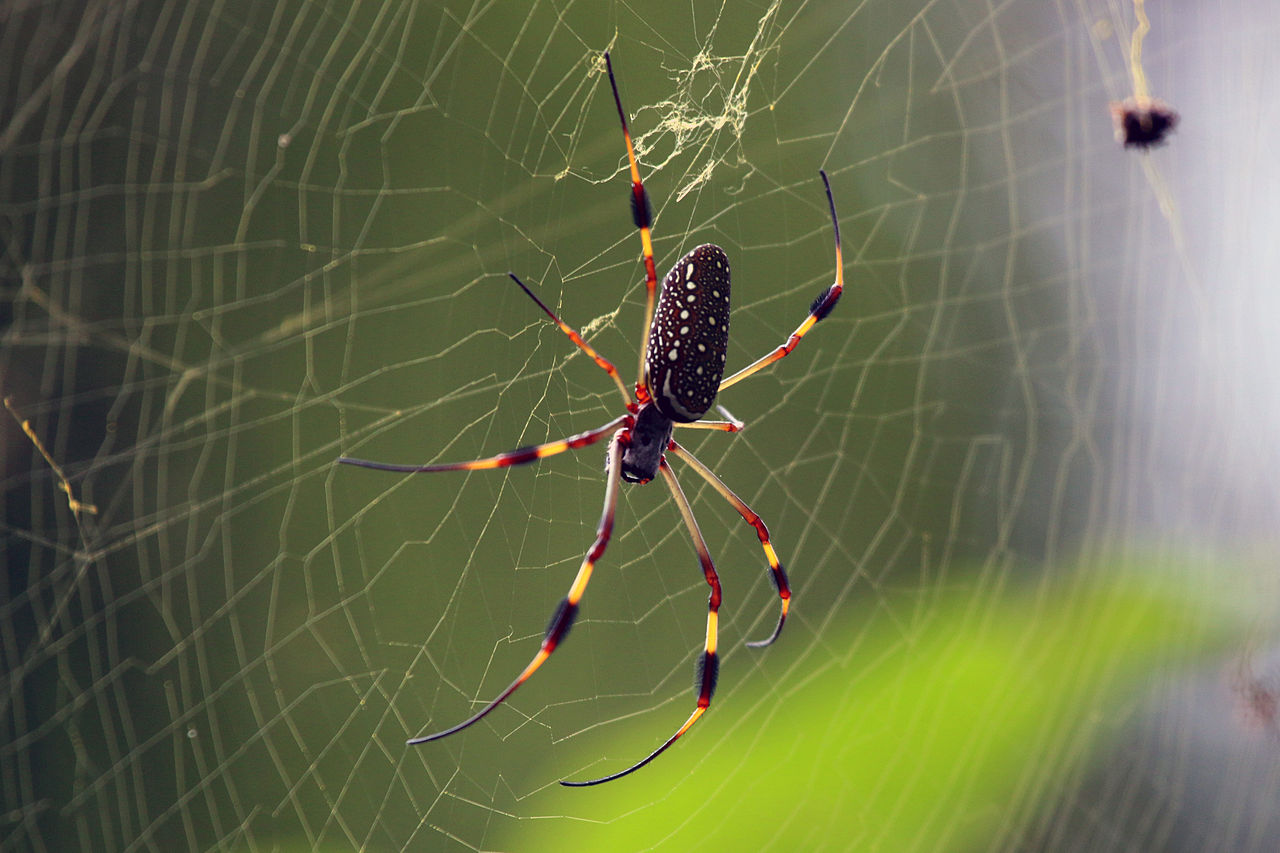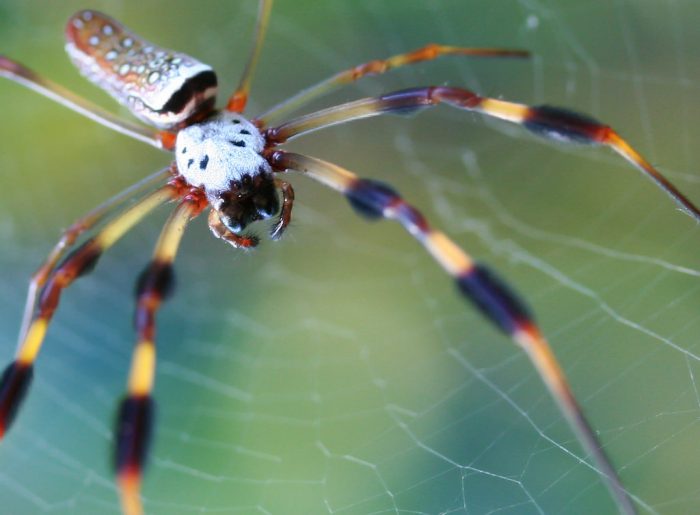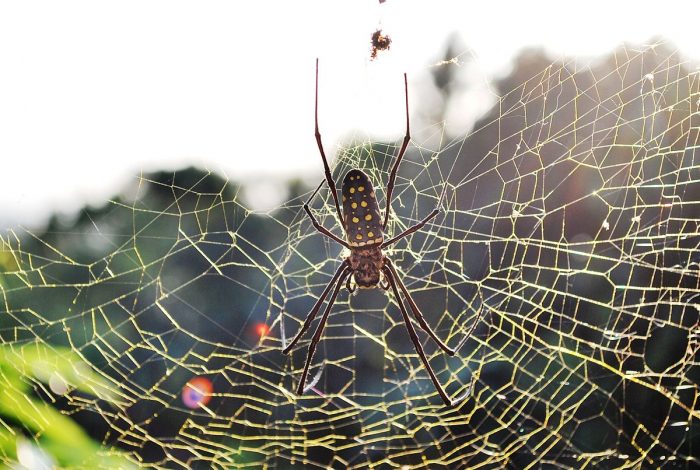
“Banana spider” is a colloquial name for spiders in the genus Nephila, also known by the common name golden silk orb-weavers. Spiders in the genus Nephila are known for their bright colors, long spindly leg appearance, and impressive web structures that can range up to 1.5 meters in diameter. The name “nephila” comes from the ancient Greek nein (to weave) + philos (love). Golden silk orb-weavers are found in warm regions all over the world from the US to China. The nephila genus falls under the Araneidae family, one of the largest taxonomic groupings of spiders that includes 3,000+ species distributed over 160 genera.
Generally, these spiders can be found in areas of dense vegetation and wet climates. There is only one species of golden silk orb-weaver that is endemic to the continental Americas; Nephila clavipes, a spider found in Southeastern US, across Mexico, and in the northern parts of South America. Golden silk orb-weavers do not seem to have any beneficial or harmful relationships with humans. They will sometimes use human-built structures to anchor their webs. They do not eat crops, so they are not agricultural pests, and they are not aggressive to humans. If bitten, their venom is too weak to cause any real damage to larger mammals and will leave a small blister that goes away after a day.
Anatomy/Appearance
Like all spiders, golden silk orb-weavers have a 2-segment body composed of a cephalothorax and an abdomen. Their color ranges from white to shade of red, normally with distinctive light markings on the underside of the cephalothorax. Their 8 legs are tipped inward and have a specialized shape for weaving webs. Most species display a colorful pattern of stripes and feathery tufts of hair along their legs. Orb-weaver females come in at about 1.5-2 inches while males measure a bit less than an inch. Some species in Taiwan are reported to reach up to 5 inches in length. In general, orb-weavers that live near human-populated urban areas are slightly bigger than those in rural areas, most likely due to the increased presence of food.

A female golden silk orb weaver. Credit: “Golden Silk Orb Weaver” L Church via Flickr CC BY 2.0
Orb-weavers exhibit sexual dimorphism. Despitethe size, in many species females and males display different colors. Females tend to be brighter and more patterned while males are a duller color with less patterned spots. In the single species Nephila clavipes, females display a rather large array of colors while most males are a muddy brownish color.
Though the different species of Nephila have the same general body plan, they differ with respect to small morphological features, ranging from a lightly different shape of the leg to differences in the placement of eyes. They also differ with respect to web-weaving and hunting behaviors.
Behavior/Lifecycle
Golden silk orb-weavers live in warm moist climates all over the world. They are particularly fond of ecosystems that have high levels of vegetation and insect populations, like the US southwest. Orb-weavers have an interesting way of spreading to different geographic locations. Spiderlings are small enough that they can ride wind currents, which can blow them significant distances to new habitats. For instance, every year, populations of orb-weavers show up in New Zealand after being blown across the Tasman sea from mainland Australia.
Spiders in Nephila are obligate carnivores and feast on insects, other spiders, and whatever else happens to stumble into their large web structures. Some species have even been observed eating birds and bats that become tangled in their strong threads. The diet of orb-weavers changes over their maturation. While spiderlings, they hang out on their parent’s web, eating dead siblings and dead prey, but they won’t attack living things. Once they move to their own individual webs do their tastes mature, and they begin hunting living prey.
The most distinctive feature of orb-weavers is their construction of dense orbs of webbing that double as a home and as their main hunting tool. These interconnected mass of threads can reach up to 1.5 meters in diameter and are strong enough that they can completely immobilize some birds and smaller mammals that become tangled. The Queensland golden silk orb-weaver from Australia is especially known for its taste in birds. The name “golden silk” comes from the yellow color of their silk and the way it glows in the sun. The pigments that causes the yellow color are carotenoids, the same kind of pigments that give carrots their orange-ish yellow color.

Credit: J Guzman via WikiCommons CC BY-SA 4.0
Orb-weavers build the web tangle via an elaborate dance. They begin by floating a line on the wind across to another surface and then form a center line, forming a y-shape. The rest of the nest is radially centered around the vertex of the y shape, topped with a series of sticking cross threads that catch prey. Orb-weavers posses a specialized claw tip, that has three prong tips, one of which the spider uses to crawl across its web without getting stuck. The vibrations caused by struggling prey alert the spider, where it descend and stuns its food with a quick bite. It wraps its prey in a web of silk which it then starts to feed on. At the end of the day, the spider will consume any bits of the web that are no longer functional. Orb-weavers replenish their webs almost daily as the stickiness of the substance that catches prey quickly declines with age.
Reproduction for orb-weavers is a rather unceremonious affair. Once mature, male spider leave their next and go out searching for a mate, which they distinguish based on the characteristic web patterns of females. Once finding a female, males will approach and tap on her web, waiting for a response. If the female is amenable, they will approach and begin copulation. Females often allow multiple males to copulate at the same time, as the energy cost of fighting off males is higher than allowing them to mate. Males tend to prefer larger female specimens as larger females can carry more eggs. Golden silk orb weavers are known to engage in sexual cannibalism, most often with larger males and older females.
After copulation, the female spider deposits her eggs in a silk wrapped sac. A female can lay anywhere from 300-3000 eggs depending on how much she mated. Eggs take about 2 weeks to hatch. During this time, the spider will sometimes move the sac around the web and obscure it from view, most likely as a defense mechanism. Once the eggs are hatched, the spiderlings occupy a communal web while they mature. During this time, spiderlings feed mainly of decaying organic material trapped on the web, but they will not attack living prey. They will also eat their dead siblings if resources are scarce.
When the spiderlings reach the juvenile stage, they leave the communal web and start creating their own individual webs. As juveniles develop, they go through 7-12 molting periods called instars, depending on how much food is available. Once the juveniles go through their last molting stage they are fully mature and begin to seek reproductive opportunities.
Most of Nephila‘s predators are normal fare for spiders: wasps, birds, and certain species of damselfly. Nephila clavipes is parasitized by dewdrops spiders, tiny kleptoparasitic spiders that steal prey and stored food from other spiders. Other species of orb-weaver spiders will parasitize Nephila clavipes as well. Egg larvae are sometimes preyed upon by moths, but not to an extensive degree.
Golden Silk Orb-Weavers And Humans
Orb-weavers generally do not form any positive or negative relationships with humans. They mostly live outdoors, so they are not common household pests (except perhaps in your garage) and they do not eat crops, so they are not agricultural pests either. In some case, they can be beneficial to crops because they eat pest like locust, flies, crickets, and beetles.
Humans have tried many times in the past to make clothing out of orb-weaver silk though very few have found any commercial viability. The main problem is, although they produce a lot of silk, most of the silk made form orb weavers is not strong enough to be used for clothing. The largest garment ever made out of golden silk is a cape and a shawl, made by textile designer Simon Peers. Peers created the garments over a period of three years using the silk from over 1 million different orb-weavers.
A handful of medical studies have also found that orb-weaver silk could be used for tissue engineering applications. Some studies have shown that processed orb-weaver silk shows promise as a scaffolding material for nerve regeneration. The silk is bio-compatible and stimulates cell production and adhesion.
To wrap up, the banana spider is another name for golden silk orb weavers, a species of spider known for their unique appearance, colorful silk, and large web structures. Orb-weavers are obligate carnivores and subsist on a diet of insects, small arthropods, and, in some cases, larger birds and mammals. Nephila are found worldwide, mostly in regions with warm climates and areas of high vegetation.








